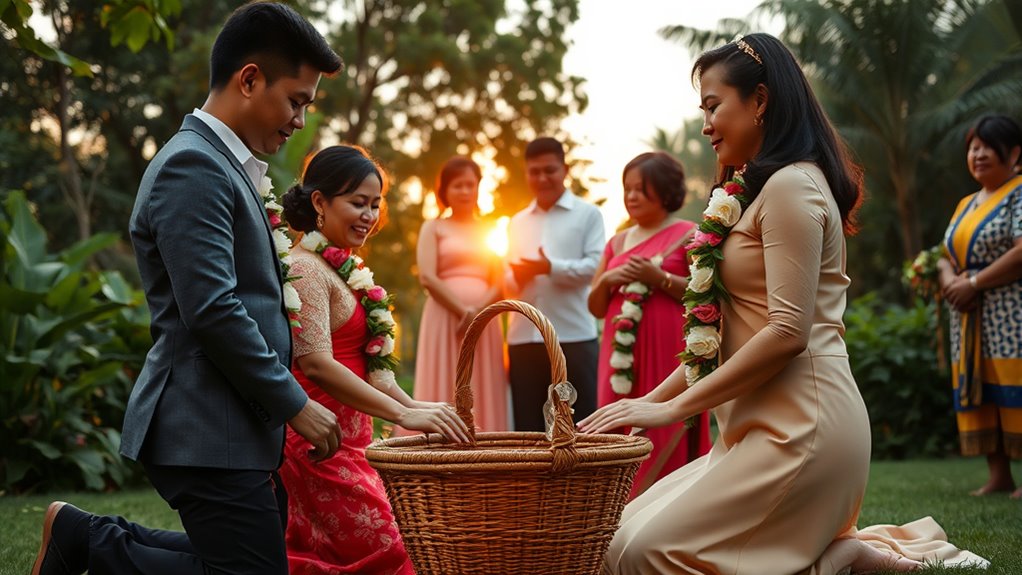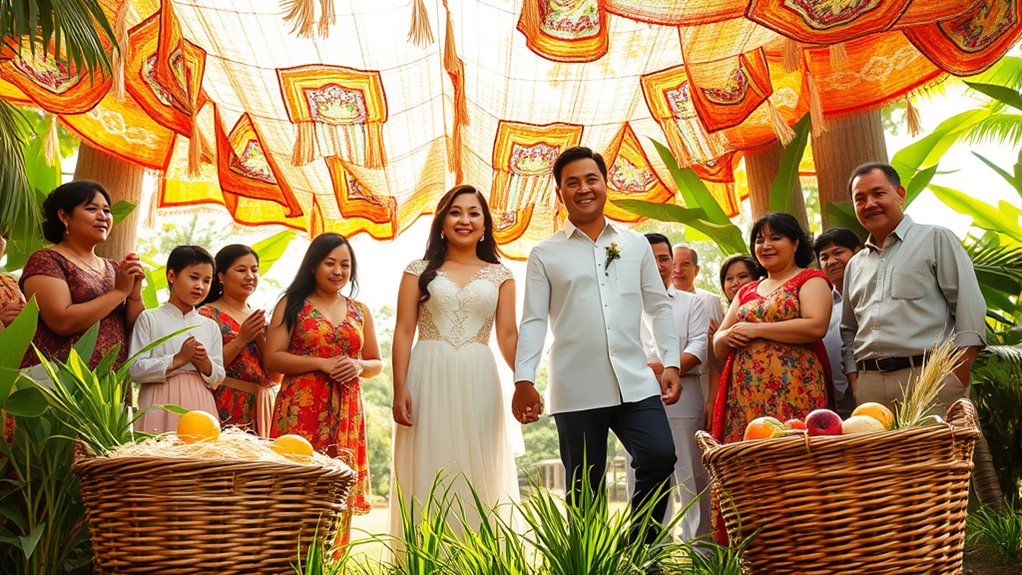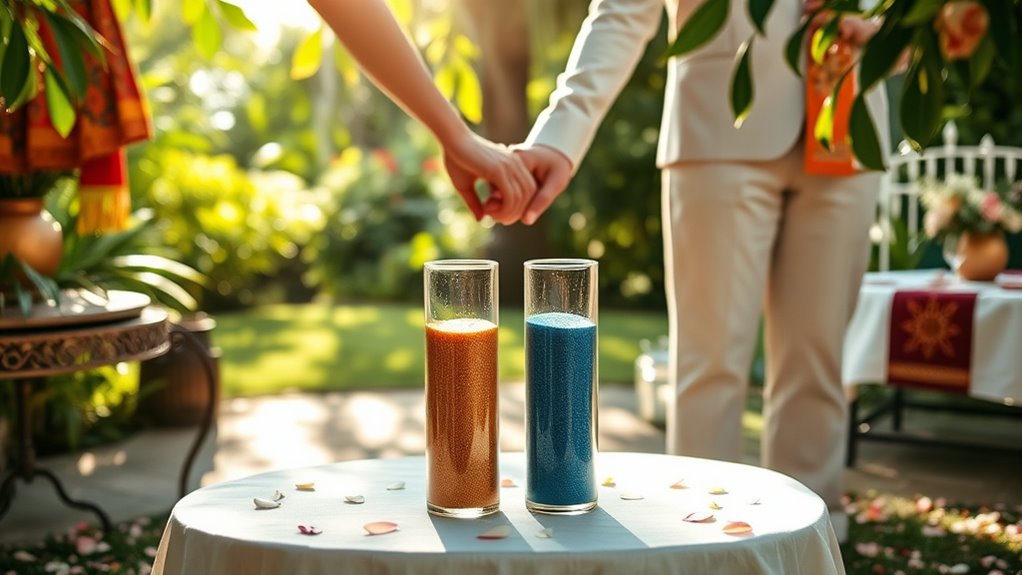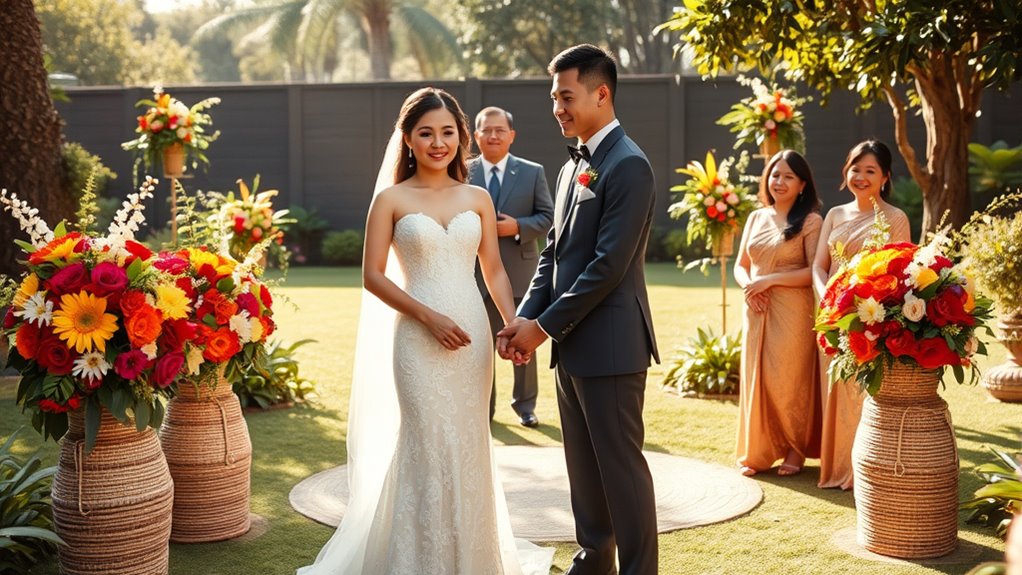Incorporating Filipino traditions into your wedding vows enriches the experience. Consider starting with “Pamanhikan,” emphasizing respect and family unity. Express love through “Harana” by adding a romantic serenade or poetry. Honor your partner’s family with the gesture of “Mano,” showing reverence. Weave in “Bayanihan” values to highlight teamwork and mutual support. Celebrate family bonds with “Kapit-Bisig,” symbolizing unity. There’s so much more you can include to make your vows truly special.
Key Takeaways
- Integrate “Pamanhikan” to express respect for families and commitment to unity in your vows.
- Include elements of “Harana” by adding poetry or music to evoke romantic memories.
- Use the “Mano” gesture in your vows to honor your partner and their family culturally.
- Emphasize “Bayanihan” values by promising to support each other and work as a team in your marriage.
- Celebrate family bonds through “Kapit-Bisig,” highlighting the importance of unity and collective strength in your partnership.
The Significance of “Pamanhikan” in Your Vows

When you incorporate “Pamanhikan” into your wedding vows, you’re not just honoring a tradition; you’re also deepening your connection to your partner and both families.
This act symbolizes respect and commitment, showcasing the importance of unity in relationships. By acknowledging the practice of seeking parental approval and guidance, you’re emphasizing the role of family in your love story.
It highlights the values of love, respect, and partnership—essential elements in any marriage. Mentioning “Pamanhikan” in your vows also serves as a reminder of the foundation on which your relationship is built.
It’s a beautiful way to intertwine heritage with modern love, ensuring that both your past and future are woven together. Embrace this meaningful tradition as you commence on your journey together.
Expressing Love Through “Harana”

How can the romantic tradition of “Harana” enhance your wedding vows? By incorporating this heartfelt serenade into your vows, you can express your love in a uniquely Filipino way.
Imagine standing before your partner, sharing a promise that reflects the deep emotions captured in a “Harana.” You might start with a simple line that echoes the melodies sung to woo your beloved.
Picture yourself before your partner, pledging a promise steeped in the heartfelt emotions of a “Harana.”
Consider writing your vows to include elements of poetry and music, drawing inspiration from classic serenades. This adds a personal touch and evokes nostalgia for the romance of your courtship.
Singing or reciting a line can create an unforgettable moment during your ceremony, reminding both of you of the love that blossomed through sweet serenades. Additionally, these vows can serve as a reminder of spiritual principles, such as love and compassion, which are foundational to your relationship.
Incorporating “Mano” as a Gesture of Respect

As you weave Filipino traditions into your wedding vows, incorporating the gesture of “Mano” serves as a beautiful way to honor your partner and their family.
This traditional act involves taking an elder’s hand and placing it on your forehead, symbolizing respect and reverence. You can weave this gesture into your vows by expressing your commitment to uphold the values of respect and honor towards your partner’s family.
Consider saying something like, “I promise to always show respect to your elders, just as I embrace the ‘Mano’ tradition.”
By doing this, you not only acknowledge your partner’s roots but also reinforce the importance of family in your union.
It’s a heartfelt addition that deepens your vows with cultural significance.
Weaving “Bayanihan” Values Into Your Promises

Incorporating the spirit of “Bayanihan” into your wedding vows can strengthen your commitment to partnership and community.
Begin by acknowledging the importance of teamwork in your relationship. You might say, “I promise to support you in every endeavor, just as we lift each other during challenges.”
Highlight the value of shared dreams and collective growth. For instance, you could vow, “Together, we’ll create a life that reflects our shared values and aspirations.”
Embrace the idea of serving not just each other, but also your community. Consider including a promise like, “I’ll always stand by you as we give back to those around us.”
Celebrating Family With “Kapit-Bisig”

Embracing the concept of “Kapit-Bisig” in your wedding vows can beautifully highlight the significance of family in your relationship. This Filipino tradition symbolizes unity and support, reminding you to lean on each other and your families as you build your future together.
You might express your commitment to not only each other but also to nurturing the bonds with your loved ones. Consider including phrases like, “Together, we’ll embrace our families’ love and guidance as we journey through life.”
This reinforces the idea that your marriage isn’t just about the two of you; it’s about weaving families together. By honoring “Kapit-Bisig,” you celebrate the collective strength that family brings, ensuring it remains a cornerstone of your partnership.
The Symbolism of “Sand Ceremony” in Filipino Culture

While you may be familiar with various wedding rituals, the “Sand Ceremony” holds a unique significance in Filipino culture. This beautiful tradition symbolizes the unity of two individuals, blending their lives together as they pour different colored sands into a single container.
Each color represents your distinct backgrounds, experiences, and personalities, merging to create something new and beautiful. As you perform this ritual, you acknowledge that your union isn’t just about love but also about the blending of families and cultures.
It’s a reminder that, like the grains of sand, you both are unique yet inseparable. Incorporating this ceremony into your wedding vows emphasizes commitment and the strength of your partnership, making your ceremony even more meaningful.
Honoring Ancestry With Traditional Sayings and Proverbs

Traditional sayings and proverbs can add profound depth to your wedding vows, connecting you to your ancestry and cultural heritage. Incorporating phrases like “Ang hindi marunong lumingon sa pinanggalingan ay hindi makararating sa paroroonan,” reminds you to honor your roots as you commence on this new journey. This saying emphasizes the importance of remembering where you came from while looking forward to the future.
You might also consider using “Sa hirap at ginhawa,” which highlights your commitment to stand by each other through both challenges and joys.
These expressions encapsulate values passed down through generations, enriching your vows with meaning. By weaving these proverbs into your promises, you create a beautiful homage to your family’s legacy and shared beliefs.
Frequently Asked Questions
How Do I Choose Which Filipino Traditions to Include in My Vows?
Choosing which Filipino traditions to include in your vows can be a heartfelt journey.
Start by reflecting on your family’s customs and what resonates with you and your partner. Consider the traditions that hold personal significance, like rituals that symbolize unity or love.
You might also discuss with family members for input. Ultimately, pick elements that authentically represent your relationship and values, making your vows a beautiful blend of both cultures.
Can I Blend Filipino Traditions With Other Cultural Wedding Elements?
Imagine a vibrant tapestry woven with threads of love, laughter, and rich heritage.
You can definitely blend Filipino traditions with other cultural elements in your wedding vows. Picture your vows embracing the warmth of a Filipino “simbang gabi” alongside a cherished ritual from another culture.
This fusion creates a unique narrative that honors your backgrounds, making your commitment even more special.
Don’t be afraid to mix and match; it’ll reflect your beautiful journey together.
What Are Some Modern Interpretations of Traditional Filipino Wedding Practices?
Modern interpretations of traditional Filipino wedding practices often blend cultural elements with contemporary themes.
You might see couples incorporating creative themes into the “sand” or “unity candle” ceremonies, using personalized colors or meaningful symbols.
Instead of traditional attire, some choose modern designs that still honor cultural heritage.
Couples also embrace technology, streaming their ceremonies online, ensuring loved ones near and far can witness their special day while celebrating Filipino customs in a fresh way.
How Can I Involve Non-Filipino Guests in These Traditions?
To involve non-Filipino guests in your wedding traditions, consider sharing the meanings behind each ritual during the ceremony.
You could create a program that explains the significance of the practices, ensuring everyone understands and appreciates them.
Encourage participation by inviting guests to join in specific rituals, like lighting candles or sharing a dance.
This way, you foster a sense of unity and celebration, making your special day memorable for everyone involved.
Are There Specific Filipino Phrases or Words to Include in My Vows?
You can definitely include some beautiful Filipino phrases in your vows!
Consider saying “Mahal kita,” which means “I love you,” to express your deep affection.
You might also want to incorporate “Sama-sama tayo,” meaning “We are together,” to emphasize your commitment.
Adding these phrases not only honors your heritage but also creates a touching moment for everyone present, showing the strength of love that transcends cultures.
Your vows will feel even more special!
Conclusion
Incorporating Filipino traditions into your wedding vows adds depth and meaning to your commitment. By embracing customs like “Pamanhikan” and “Harana,” you’re not just honoring your heritage but also weaving a rich tapestry of love and respect. Remember, it’s the little things that count; every gesture strengthens your bond. As you stand together, let these traditions remind you that, together, you can weather any storm and build a beautiful future side by side.









